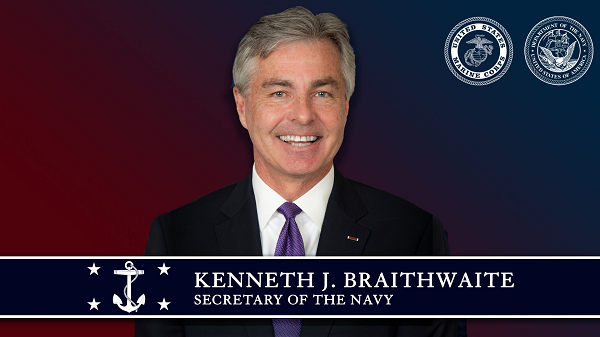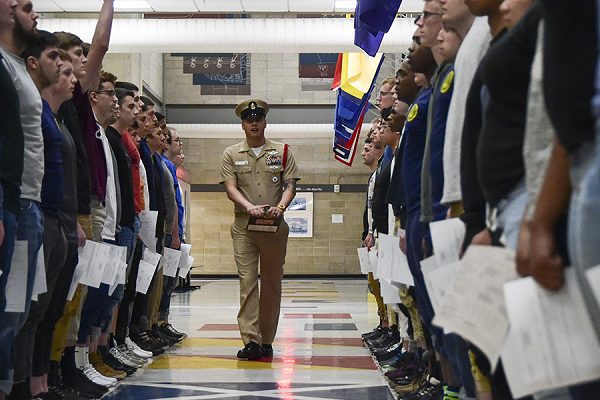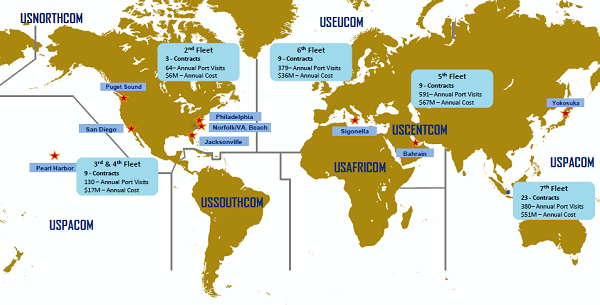The Navy has both administrative and operational chains of command.
Typically, a new recruit concerns themselves with their operational chain of command but must memorize the top positions.
However, those in the Navy who are no longer recruits have a chain of command based on their job and assigned command.
Navy Chain of Command/Organization

- President of the United States
- Secretary of Defense
- Secretary of the Navy
- Chief of Naval Operations
- Combat Commands
- Component Commands
- Numbered Fleets
- Task Forces/Groups/Units/Elements
- Vessels
Related Article – Navy vs. Air Force
President of the United States
The President of the United States (POTUS) is the Commander-in-Chief and is the top of the chain of command for all branches of the military.
Secretary of Defense
The Secretary of Defense answers to the President of the United States.
Also, the Secretary of Defense handles the military’s operation and administration.
Currently, the Secretary of Defense is Christopher Miller, although it may change with a new President.
Secretary of the Navy
The Secretary of the Navy is the highest rank in the US Navy’s chain of command.
As the chief executive officer, he or she reports directly to the President of the U.S. and the Secretary of Defense.
Among other responsibilities, the Secretary of the Navy looks after the construction and repair of US Navy ships.
Also, the secretary handles the implementation of procedures in line with the security policies set forth by the POTUS.
As of December 2020, the current Secretary of the Navy is Kenneth Braithwaite.
Chief of Naval Operations (CNO)
This position involves a senior military officer who advises the President and the Secretary of the Navy.
Furthermore, within the Office of the Chief of Naval Operations is several other high ranking officers who oversee the Navy. These include:
- Vice Chief of Naval Operations
- Master Chief Petty Officer of the Navy
- Director of the Naval Nuclear Propulsion Program
- Surgeon General of the Navy
- Chief of Navy Reserve/Commander
- Chief of Chaplains
Navy Chain of Command: Combat Commands
The Department of Defense has different combat commands, each with its mission and command.
Commanders of these commands issue orders to subordinates and subordinate components.
- Africa Command
- Central Command
- Cyber Command
- European Command
- Indo-Pacific Command
- Northern Command
- Southern Command
- Space Command
- Special Operations Command
- Strategic Command
- Transportation Command
Navy Chain of Command: Component Commands
The Navy has nine component commands, and the commanders handle the operations for each.
- Fleet Forces Command
- Military Sealift Command
- Naval Forces Central Command
- S Pacific Fleet
- Naval Forces Southern Command
- Naval Forces Europe/Africa
- Naval Special Warfare Command
- Fleet Cyber Command
From an organizational standpoint, commanders for the component command report to their assigned combatant commander.
For instance, the Naval Forces Central Command Fleet is subordinate to the Central Command.
Navy Chain of Command: Numbered Fleets
The component commands discussed above all has their own commander.
Also, the commanders for the component commands oversee numbered fleets.
There are two Fleet Commanders-in-Chief who look after subordinate commanders.
Therefore, the numbered fleets have commanders that are typically Vice Admirals.
At the moment, there are seven numbered fleets:
- 2nd Fleet – Operates under Northern Command/Fleet Force Command
- 3rd Fleet – Operates under Pacific Fleet/Pacific Command
- 4th Fleet – Operates under Naval Forces Southern Command/Southern Command
- 5th Fleet – Operates under Naval Forces Central Command/Central Command
- 6th Fleet – Operates under Naval Forces Europe/European Command
- 7th Fleet – Operates under Pacific Fleet/Pacific Command
- 10th Fleet – Operates under Fleet Cyber Command/ Cyber Command
Navy Chain of Command: Task Forces/Groups/Units/Elements
Navy fleets are vast, but when you look at who tasks ships and submarines, you find the groupings are too small to accomplish missions.
Therefore, the fleets are divided into task forces, groups, units, and elements.
Task elements are the smallest, with the most focus on missions.
In all cases, the assignments are based on warfare specialty.
Task force commanders command these combat forces.
Because the Navy has both operational and administrative sides, those who command fleets and task forces are free to focus on their combat-related missions.
Task Elements
A task element is the smallest part of a unit.
Task Unit
A task unit is made up of task elements with a shared task or goal.
For instance, A strike Task Unit is comprised of two elements that fall under the command of a Carrier Strike Group.
Task Group
A Navy task group is typically a carrier strike group or an amphibious ready group within one of the fleets.
Also, the task group is comprised of units and elements with a shared mission.
Task Forces
Task forces are the broadest category, and the task forces answer to the fleet commander.
Related Article – Navy Boot Camp Graduation Dates for 2020
What Should a New Recruit Know About Navy Chain of Command?

A Navy recruit will memorize those at the top of the chain of command.
However, there is a chain of command relevant to a recruit while a part of the Recruit Training Command.
- Recruit Division Commander
- Ship’s Leading Chief Petty Officer
- Ship’s Officer
- Executive Officer, Recruit Training Command
- Commanding Officer of Recruit Training Command
- Naval Service Training Command
- Commander of the Naval Education and Training Command
- Chief of Naval Personnel
- Chief of Naval Operations
- Secretary of the Navy
- Secretary of Defense
- President of the United States
References:
- Replacing Dog Tags: 6 Things You Need to Know - June 28, 2024
- Navy OAR Test Study Guide - June 24, 2024
- 10 Best Sniper Movies of all Time - June 20, 2024
Originally posted on December 27, 2020 @ 2:52 pm
Affiliate Disclosure: This post may contain affiliate links. If you click and purchase, I may receive a small commission at no extra cost to you. I only recommend products I have personally vetted. Learn more.

